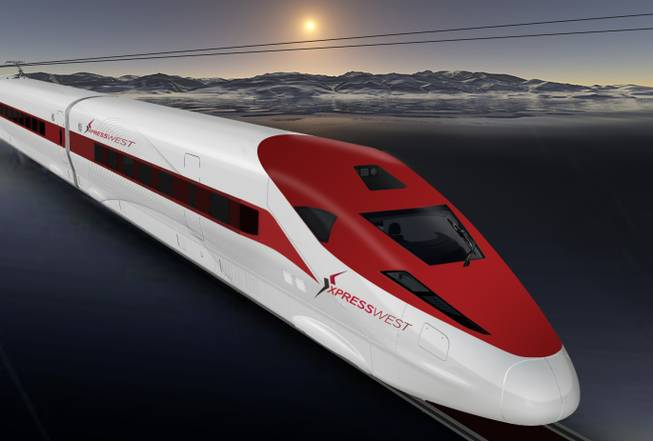
Courtesy of XpressWest
An artist’s rendering of a train on the XpressWest high-speed rail line.
Monday, Aug. 7, 2017 | 2 a.m.
Where the rail would run
The initial line from Las Vegas to Victorville would run mostly adjacent to Interstate 15, with a roundtrip ticket costing less than $100. That route is enabled by XpressWest’s 2011 lease agreement with the Bureau of Land Management for the federal land making up most of the project’s 185 miles of railroad right-of-way.
When XpressWest was chosen in 2015 to build a high-speed rail system between Las Vegas and Southern California, the company said it could start construction as early as fall 2016.
That didn’t materialize, but XpressWest — owned by local developer Tony Marnell — continues to chip away at the vision of a train that would link Las Vegas and Victorville, and eventually run into Los Angeles County.
Announced in 2009 as DesertXpress, Marnell’s outfit changed its name in 2012 to reflect its role as the initial portion of a larger high-speed passenger rail network in the West. The company initially planned to privately fund $1.4 billion of the project and finance the rest of the stretch to Victorville with a $5.5 billion loan from the Federal Railroad Rehabilitation and Improvement program. That loan was denied in 2013 and suspended indefinitely for a project that as of 2016 was projected to cost $8 billion.
In 2015, XpressWest entered into a joint-venture agreement with China Railway International, which was to assist in financing, building and possibly operating the rail system. But the agreement was dissolved in June 2016.
Last month, Chief Operating Officer Andrew Mack provided an update (mandated every six months) to the Nevada High-Speed Rail Authority. Here are key topics he covered:
Strength of the Southern California market
Published this year by the High Desert Corridor Joint Powers Authority, a ridership and revenue study by Steer Davies Gleave revealed that California residents accounted for 29 percent of the almost 43 million visitors to Las Vegas in 2016. And 90 percent of them drove.
“A very significant automobile segment, which we’ve always understood, is who we’re really competing against. It’s not the airplane,” Mack said.
Although McCarran International Airport has seen an increase in the number of travelers accommodated each year, the study showed 75 percent of foreign travelers didn’t fly directly into Las Vegas. “They travel into Los Angeles and go on to Las Vegas,” Mack explained.
Scenarios for route expansion
Aside from the baseline project between Las Vegas and Victorville, the study looked at other scenarios of implementation and timing.
After the initial project is completed, the next leg would be to Palmdale, Calif., where riders could then take a Metrolink train to get into other areas of Southern California.
The next segment would reach Burbank, marking the “one-seat ride” milestone — a transferless high-speed journey from Burbank to Las Vegas.
Lastly, the system would travel into Anaheim, creating connectivity to Central and Northern California.
“What this study shows is that the Las Vegas-to-Victorville project, in and of itself, has the ridership and revenue necessary to support the project’s financing, including the capital and operating,” Mack said.
The other segments aren’t financially feasible at this point because of the density of the Los Angeles Basin and the increased costs of capital and infrastructure improvements, despite a higher ridership in the area, Mack said.
Growth potential for travel market
According to the study, 26 million round-trips from Southern California to Las Vegas were made in 2015, and that’s expected to increase to 47 million by 2050 (the number includes air and road travel). The high-speed rail project could draw about 21 percent of the total travel market by 2024, adding 400,000 travelers who otherwise wouldn’t have made the trip. By 2050, it could draw 27 percent — 1.4 million travelers — and bring in $1.6 billion in revenue.
“It’s validation of the market, travel demand and capture-rate for high-speed rail, not only for the Los Angeles-to-Las Vegas corridor, but specifically for the Las Vegas-to-Victorville project,” Mack said. “It gives us a very current investment-grade view on what that potential market size, corresponding revenue and ridership would be.”
Federal funding prospects
High-speed rail advocates got a boost in 2009, when then-President Barack Obama included $8 billion for high-speed rail in his economic-stimulus package. But little came out of it, and the climate is uncertain under the Trump administration. “There’s no infrastructure planned or federal direction as we sit today on high-speed rail,” Mack said. “It’s clear that health care and tax reform are priorities, and then infrastructure. We’re kind of third in that race right now.”
Encouraging foreign investment in the U.S. is a way to gain funding, Mack said. A phased approach to buy-America requirements — that high-speed rail components be built domestically — is key. “The reality is there’s still no U.S. manufacturer of high-speed trains,” he said. “So there is a conflict at the federal level, because the safety side wants to see proven train sets.”
The California High-Speed Rail Authority was granted a waiver from the Buy American Act, and so was Amtrak for its Northeast Corridor project servicing areas including Washington, D.C., New York City and Boston.
“We saw that as a positive step because it allowed there to be this phased approach,” Mack said of the ability to use foreign-made materials, though California’s rail authority reversed its plans and withdrew its waiver request after criticism from California congressional members. “Despite the negative outlook, we are continuing discussions with potential partners and investors for how we can solve those problems. But today, we don’t have the answer.”

Join the Discussion:
Check this out for a full explanation of our conversion to the LiveFyre commenting system and instructions on how to sign up for an account.
Full comments policy